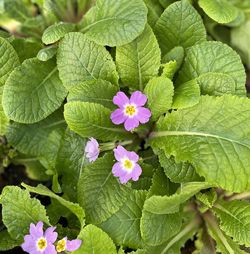Includes Hakonechloa, Luzula, Miscanthus, Muhlenbergia, Panicum, Schizachyrium, & Stipa
Elymus
Wheat Grass
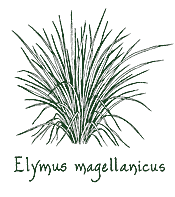
The color of sky and sea, Elymus’s light blue glaucous blades gain intensity as the plant matures and assumes its delightful skirtlike habit. Older leaves fall outward to cover the base, revealing the new, upright central growth.
A designer’s dream, Wheat Grass holds its form without the distraction of conspicuous flowers, and is unparalleled in a container or as a specimen for the mixed border against a drift of green Carex tumulicola. Happiest in coastal areas, this extraordinary blue grass appreciates well drained soil, and light shade in hot climates.
Size: 15" high x 18" wide.
Hardy to zone 6.
Equisetum
Horsetail
Equisetum hyemale var. Robustum (G-0071)
Each $11.75
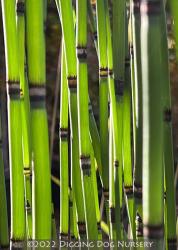
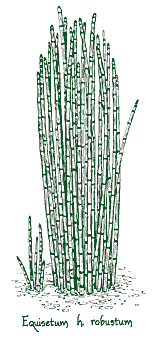
Boasting a strong architectural appeal, this easily grown California native has sturdy bamboo-like stems, which remain evergreen in warmer climates and grow much taller than the species. The deep green clumping shoots are divided by brown joints and, because they contain silica, were once used to polish tin and wood. A topnotch specimen, in or out of water, Giant Scouring Rush’s straight-up, energetic habit should only reside in containers.
Size: 5' 0" – 7' 0" high x 2' 0" – 3' 0" wide.
Hardy to zone 4.
Eragrostis
Elliott’s Lovegrass
Eragrostis elliottii ‘Wind Dancer’ (G-0592)
Each $11.75
Witness the ethereal haze of fluffy white flowers that float upon lax slender stems and you’ll see how the namesake came to be. While the native species inhabits the open woodlands, sandy enclaves and prairies of Georgia and the Carolinas, this undemanding warm season cultivar will bring a handsome fine textured mound to your backyard. Cushioned by flowing glaucous blue-green blades, the long-lasting gauzy panicles develop buff and straw tones as the season progresses, tantalizing birds, florists and gardeners through early winter. ‘Wind Dancer’ can be featured in large containers and as a soft-looking specimen in mixed borders, or it can be massed for native and meadow gardens plus planted on hillsides for erosion control. Love Grass prefers moderately moist well-drained abodes, but abides dry conditions, poor soil and black walnut roots.
Blooms July–November
Size: 2' 0" – 3' 0" high x 2' 0" – 3' 0" wide.
Hardy to zone 6.
Eragrostis spectabilis ‘’ (G-0563)
Each $13.00
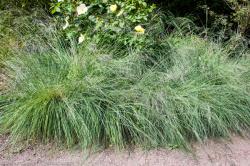
A widespread North American resident, this irresistible warm season bunch grass gives you good reason to love it. The low, loosely arranged narrow light green blades launch tall thin flower stalks that cushion a lovely fine textured cloud of reddish purple seed heads in late summer. Bronze and burgundy-streaked autumn foliage extends the show. A butterfly’s friend and a gardener’s delight, Eragrostis spectabilis asks for good drainage and possesses unfaltering mettle, miraculously abiding air pollution and black walnuts as well as dry, poor, sandy or gravel-strewn sites.
Blooms July–September
Size: 18" – 2' 0" high x 2' 0" wide.
Hardy to zone 5.
Eriophorum latifolium (G-0476)
Each $11.75
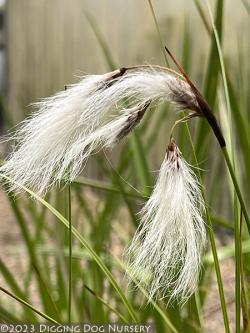
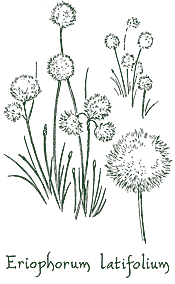
Greek for “wool bearing,” the genus name alludes to the light-as-a-feather, white cloud-like blooms of this wet marshlands dweller from the British Isles and Eurasia. The dense cotton balls dreamily float some 12 to 18 in. above a handsome clump of light green, finely textured foliage. Described by numerous thin bristles that extend beyond the flower spikelets, the unique inflorescences make bright, fluffy additions to dried arrangements, and later evolve into wispy nodding tufts. Thriving in moist soils yet sulking in hot, dry conditions, Cotton Grass is most effective en masse in a naturalized setting or by water’s edge intermingled with Euphorbia ‘Great Dixter’s warm accents.
Blooms April–June
Size: 2-1/4' high x 18" wide.
Hardy to zone 4.
Fargesia
Clumping Bamboo
Fargesia dracocephala ‘Rufa’ (G-0534)
Each $18.75
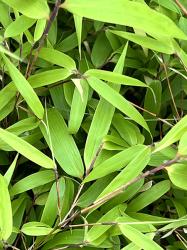
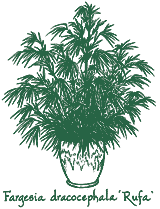
A favored snack for giant pandas and an airy grand spectacle for any gardener, ‘Rufa’ is one of the most hardy and versatile noninvasive Bamboos available. Prominent, paper-like rusty-red sheaths and long, narrow deep green leaves enhance courtly polished culms. Unleashing numerous new shoots each season, this vigorous Bamboo can be utilized as a year-round star specimen or planted en masse as a privacy hedge. Regular water and protection from hot afternoon sun ensure its success.
Size: 8' 0" high x 6' 0" wide.
Hardy to zone 5.
Festuca
Fescue
Originating from the Latin word for stalk or stem, the genus Festuca is comprised of approximately 300 cool season perennial species. The following selections highlight natty fine textured tufts, which appreciate well-drained sites and a division every couple of years, while pouting in hot humid weather.
Festuca amethystina ‘Superba’ (G-0527)
Each $12.25
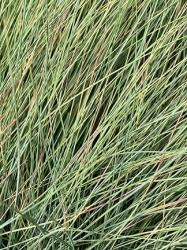
An inhabitant of central Europe, this finespun grass is practically peerless among Festucas. Soft silver-blue blades with rolled edges shape a well-groomed glaucous mound. Extending above evergreen clumping foliage, quantities of relaxed narrow stems generate vivid heliotrope shades paired with amber-hued flower spikes for more than a month. ‘Superba’ can serve as a dynamic small-scale specimen sprinkled above a stone wall or throughout the rockery, where it favors an annual early spring trimming and its stunning color always beckons.
Blooms mid May–mid July
Size: 18" – 2' 0" high x 2' 0" – 2-1/2' wide.
Hardy to zone 4.
Festuca californica ‘Phil’s Silver’ (G-0462)
Each $12.25
A focal point for its stiff silvery blades, this robust grass originated from seed that Cal Flora Nursery owner, Phil Van Soelen, collected near California’s Sonoma coast. Anchored by burgundy sheaves, glaucous gray-green leaves remain evergreen in milder climates and become more lustrous as the weather warms. Unfurling in open, yet showy, abundance, the nimble greenish panicles mature to a golden hue some 2 or 3 ft. above a fairly compact, dense basal tuft of enduring handsome foliage. Resplendent massed with shrubs such as Ceanothus, Cistus or Ribes, ‘Phil’s Silver’ prefers minimal to moderate summer water and obliges an array of situations, such as coastal slopes, wind and drought in cooler locations.
Blooms April–June
Size: 3' 0" high x 3' 0" wide.
Hardy to zone 7.
Selected by Cal Flora Nursery from seed they collected near Willits, CA, this extra-energetic gray-green grass grows twice the size of most California Fescues. Slim blades forge a dapper mounding habit tossing exquisite lofty flower stalks, which house pendulous spikelets with rose-tinged blooms on arching, loosely arranged branches. A butterfly’s delight but no friend to deer, ‘Willits’ Giant’s steadfast temperament can be massed on slopes plus featured as a specimen in mixed borders and partly shady garden beds or as a ground cover beneath native oak trees. Periodic watering and not-so-cold winter temperatures maintain its evergreen good looks.
Blooms May–June
Size: 5' 0" – 6' 0" high x 3' 0" wide.
Zone 7b/8.
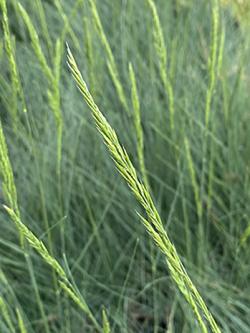
We have nurseryman and botanist Henry Eilers to thank for this adaptable good-looking toughie that he chanced upon in Turkey. The arching, ever-so-fine matte-green foliage supports a showy array of lanky tail-like sand-colored blooms atop firm red-suffused stalks. Most likely of Festuca ovina parentage, ‘Eilers Beauty’ lends an inviting aspect to mixed borders or more relaxed plantings, where it can accompany Euphorbia ‘Blue Haze’ and Helianthemum ‘Fire Dragon’, while tackling both heat and dry shade.
Blooms May–June
Size: 20" high x 20" wide.
Hardy to zone 4.
Festuca idahoensis ‘Stony Creek’ (G-0488)
Each $12.25
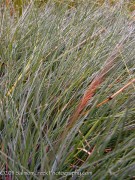
Not only beautifully blue, but hard-working to boot, this water wise perennial grass is a California native from Del Norte County. A thick, tidy hummock of very thin, chalk blue blades sends up slender, wandlike stems holding graceful, airy golden sprays.
Hallmarked by a composed appearance, ‘Stony Creek’ is most impressive and enduring in large drifts on banks or hillsides, where it aids erosion control, resists those pesky deer, doesn’t falter in full sun even inland, and prefers some afternoon shade.
Blooms April–June
Size: 2' 0" – 2-1/2' high x 2' 0" wide.
Zone 7/8.
Indigenous to Morocco’s Atlas Mountains, this long-lived cold-hardy grass sprouts an elegantly arching fountain distinguished by dapper khaki-tinged gray-green blades. Taller than most Festucas, Atlas is reputed to be one of the finest large area ground covers, proving essential for mass plantings on slopes, in mixed borders or natural-style meadows. Evergreen where winters are mild and remarkably drought tolerant, its reliable good-looking mound relishes occasional waterings and doesn’t require a trim, only a little raking.
Blooms June
Size: 2' 0" – 3' 0" high x 2' 0" – 3' 0" wide.
Hardy to zone 4.
Hakonechloa
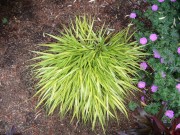
These graceful members of the Poaceae family are named after Hakone, a region of Japan where they can be found growing wild in shady areas with humus-rich soil.
Each $12.25
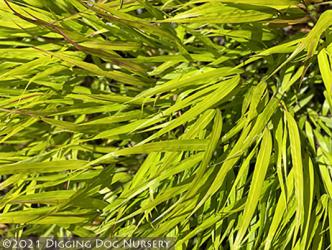
A study in urbane simplicity, this vivid green grass fashions plush mounds of flowing bamboo-like foliage. Hakonechloa macra has often been overlooked, though its faster growing habit has a lot to offer, withstanding more sun, drought and cold than the variegated Hakones. Solidly colored blades offset striped, gold, bronze or broad-leafed plants to great effect, or meld with Buxus ‘Blauer Heinz’ for a meditative green-on-green composition.
Size: 12" – 3' 0" high x 12" – 3' 0" wide.
Hardy to zone 4.
Hakonechloa macra ‘Albo Striata’ (G-0062)
Each $12.25
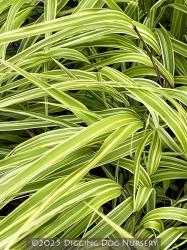
Always a celebrated cultivar, this Japanese forest grass is more sun tolerant than the golden form. The pendulous green foliage is adorned with irregular thick and thin creamy-white stripes. Preferring dappled light, ‘Albo-Striata’ will brighten your days whether planted in the rock garden or a container, along pathways or beneath a dwarf Maple.
Size: 12" high x 2' 0" wide.
Hardy to zone 6.
Hakonechloa macra ‘All Gold’ (G-0477)
Each $12.25

Gleaming with the clearest gilded shades imaginable, ‘All Gold’s broad foliar ribbons are surely the envy of King Midas! This slightly more upright Hakonechloa possesses the characteristic fluid ease of our other cultivars, and when set amid Astrantia ‘Moulin Rouge’, its radiant, fountain-like blades convey a dazzling vitality in any shady nook.
Size: 18" high x 18" wide.
Hardy to zone 6.
Hakonechloa macra ‘Aureola’ (G-0051)
Each $12.25
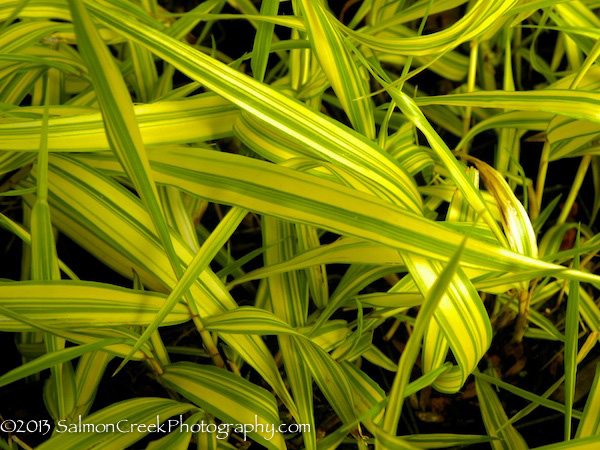
This dwarf cool season grass is lush and courtly. Cascading, satin-like foliage is broad and variegated with cream, chartreuse and green, illuminating dark garden corners and softening hard features. Appreciative of moist well-drained soil, ‘Aureola’ makes a choice specimen or slow spreading ground cover. We especially enjoy it in Japanese gardens as well as under the ambient light of Corylopsis pauciflora.
Size: 15" high x 18" wide.
Hardy to zone 6.

With the same pendent elegance as its relatives, ‘Beni-kaze’ entertains brilliant red fall color. A verdant mound of draped loosely arranged blades remains green until cooler weather ignites the smooth foliar ribbons and begs its name, which translates to “red wind.” Lounging in the late season shadows, this larger growing Hakonechloa echoes the warm-hued fanfare of autumnal foliage.
Size: 18" – 20" high x 2' 0" – 2-1/2' wide.
Hardy to zone 6.
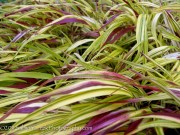
Discovered in a French trial garden, this recently introduced Hakone Grass is distinctive for its smaller stature and unique foliar blend of fall hues. The pendent, creamy white and yellow-green blades, which sport irregular green bands, appear similar to ‘Aureola’ during the spring and summer months.
Once the weather cools, some of the foliage transmutes deep reddish purple colors, while many leaves retain their bright variegation, crafting an exceptional multitoned spectacle. (pp#19,897)
Size: 10" – 14" high x 18" wide.
Hardy to zone 5.
Hakonechloa macra ‘Nicolas’ (G-0528)
Each $12.25
A vibrant foliar infusion of orange-red hues, induced by cool autumn weather, makes this compelling new cultivar unique. Reminiscent of bamboo, artful weeping blades remain deep green throughout the growing season, shaping a soft-looking low ground cover, which exhibits more sun and drought tolerance than its golden or variegated cousins plus promises not to overtake its neighbors. ‘Nicolas’ brings bold color to the season’s last curtain call and can be celebrated as a container subject, planted en masse in a naturalistic or modern venue or for a favored Japanese tradition, it can be paired with bonsai. (pp#19,898)
Size: 10" – 14" high x 18" wide.
Hardy to zone 5.
Hakonechloa macra ‘Sunny Delight’ (G-0564)
OUT OF PRODUCTION AT THIS TIME
Email me when this plant is available
Sporting the reverse variegation of its parent, ‘Aureola’, and growing slightly taller as well, ‘Sunny Delight’s slender predominately green blades showcase lambent golden yellow streaks and striations in varying widths. The shapely flowing habit makes a durable and deciduous bambooesque partner for fellow dappled shade-lovers like Geranium ‘Alec’s Pink’ or Tricyrtis ‘Blue Wonder’.
Size: 14" high x 20" – 22" wide.
Hardy to zone 5.
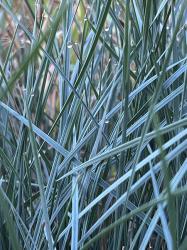
A finely textured, semievergreen selection from Germany—the best of the midsized, blue-leafed grasses—‘Sapphire Fountain’ is as coveted for its form as for its color. Bright steel-blue blades leap into arching sprays of delicate, wheat-colored inflorescences hovering 2 ft. above the clump. Prospering in low humidity and well-drained soil, this cool season grass puts on a suave year-round show in sweeps or as a specimen.
Blooms May–June
Size: 3-1/2' high x 2' 0" wide.
Hardy to zone 4.
Juncus
Rush
Juncus effusus ‘Big Twister’ (G-0576)
Each $11.75
The thick, polished, cylindrical foliage that fantastically twists, winds and corkscrews upwards defines this dramatic evergreen Juncus. Best ensconced in containers to abate the creeping rhizomes, easily grown ‘Big Twister’ is an attention-grabbing showpiece for water features, pond margins, boggy areas or even inside as a house plant. It thwarts those pesky deer, relishes bright shade plus evenly moist soil and makes an extraordinary addition to fresh or dried arrangements.
Size: 18" – 2' 0" high x 2' 0" wide.
Hardy to zone 5.
Each $11.75
Easily swayed by the slightest breeze, the upright thicket of slender, gray-green cylindrical stems has an engaging kinetic presence. This versatile grasslike perennial yields small brown flower clusters at its stem tips and makes an exceptional fine textured companion for a lush grass such as Molinia ‘Bergfreund’ in a mixed planting or along a pond or stream bank.
Found sauntering about Australia’s coastal areas, it can handle dry or moist sites and appreciates a hard late winter pruning to ensure fresh looking spring growth.
Blooms July – September
Size: 4' 0" high x 3' 0" wide.
Hardy to zone 8.
Leymus
Wild Rye
Leymus condensatus ‘Canyon Prince’ (G-0514)
Each $11.75
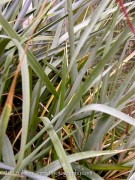
Luscious silvery blue blades—broad, highly glaucous, and upright and arching—distinguish this royal looking California native. Selected by the Santa Barbara Botanic Garden and found on Prince Island in the Santa Barbara Channel, ‘Canyon Prince’ grows into a dense, not-so-tall evergreen clump that yields slow spreading rhizomes and tightly clustered almond-colored inflorescences on straight stems.
Brimming with elegance and easy to cultivate, its unyielding fortitude shrugs off heavy soil, dry conditions and foraging deer.
Blooms July – August
Size: 3' 0" – 4' 0" high x 2' 0" – 3' 0" wide.
Hardy to zone 7.
Luzula
Wood Rush
Luzula comes from the Latin word meaning “glow worm.” These graceful rushes earn their name for the way a soft, downy hair, which covers the margins of each blade, catches and holds dew. As the morning light strikes the moistened leaves, they glisten. The handsome leafage vitalizes a garden setting with its textural infill.
Durable as a ground cover and at home in various soil types, Luzula is best when planted in drifts.
Luzula ‘Ruby Stiletto’ (G-0103)
OUT OF PRODUCTION AT THIS TIME
Email me when this plant is available
An eye catching new selection from seed collected in the mountains of British Columbia by plantsman Graham Ware, ‘Ruby Stiletto’ lives up to its name during the colder months when sumptuous ruby hues emblazon its blades. A compact hummock of spry and slender grassy green foliage in the warm seasons, this gem weaves an engaging, textural tapestry when planted en masse with drifts of Deschampsia ‘Goldgehänge’ and Molinia ‘Moorflamme’.
Size: 12" high x 8" wide.
Hardy to zone 5.
Luzula sylvatica ‘Aurea’ (G-0102)
Each $11.75
Distinguished by fine-haired light-catching margins and a lustrous finish, thick broad foliar ribbons transmute golden-green shades in spring that mellow to lime-green during the summer, then dazzle us with gilded hues once cold weather arrives. ‘Aurea’s mat-like spreading rhizomes produce a lambent evergreen clump beneath airy upright panicles of myriad yellowish green flowers and chocolate-brown seed heads. Happiest in light shade and adequately-moist alcoves, this winsome ground cover is second-to-none for mixed borders and woodland plantings, where it quells weeds plus withstands deer, tree roots, occasional drought and various soil types.
Blooms May–June
Size: 10" high x 2' 0" wide.
Hardy to zone 5.
This light green ground cover is perhaps one of the best ornamental grasses for a shady setting, especially beneath woody, deciduous shrubs. Arising from soft-looking broad foliar ribbons with twisted and downward curving tips, erect 15 in. stems hold golden inflorescences that mature handsomely to a chocolate brown. Evergreen ‘Auslese’ can tolerate some drought, and assures a blithe presence as it skirts below Sambucus ‘Black Beauty’.
Blooms mid-April–May
Size: 12" high x 18" wide.
Hardy to zone 5.
Miscanthus

If Pygmalion were a gardener, Miscanthus would come to life as fountains, some of them spouting tall and upright to 10 feet. Graceful and robust, they’re favored for their luxuriant foliage and silky terminal panicles. Striking as singular specimens, Miscanthus are also excellent when massed in the perennial bed or a mixed border. Attractive throughout most of the year, with yellow, purple, scarlet and burgundy fall colors, they fade to a lovely warm ivory in winter.
Each $13.75
A sterling Kurt Bluemel introduction, ‘Adante’ spawns strong upright stems clothed in broad green blades, distinctively etched by light central stripes. Pink-blushed plumes mature with silver-laced high-lights, projecting an unbeatable floral effect above graceful loosely arranged and somewhat pendant foliage. This probable Miscanthus transmorrisonensis descendant can frame a view, define a threshold or serve as a large awe-inspiring focal point in the landscape.
Blooms September–November
Size: 7-1/2' high x 3' 0" – 4' 0" wide.
Hardy to zone 5.
Miscanthus ‘Purpurascens’ (G-0548)
Each $13.75
This wildly popular hybrid affords an upright compact habit, superlative fall color plus an outstanding winter presence. Flushed with a reddish tinge that deepens throughout the summer, the medium green blades eventually brandish vivid orange-red fall colors. Crimped rose-hued tassels morph into creamy-white plumes, and posed against the burgundy-streaked leaves, become a stunning late summer spectacle. Alluring nearly year round especially when planted as a stand-alone or grouped, medium-sized Flame Grass earns its title once cool nights arrive.
Blooms July–February
Size: 4' 0" – 5' 0" high x 2-1/2' – 3' 0" wide.
Hardy to zone 5.
Miscanthus sinensis ‘Adagio’ (G-0468)
Each $13.75
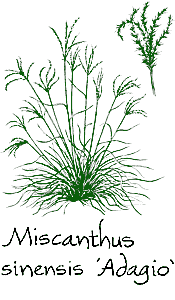
The wiry, silver gray-striped, fine textured olive-green foliage of this playful low grower is topped with pink panicles, which turn white. Small-statured ‘Adagio’ is perfect for a tight spot and as a companion to pewter-tinged leaves such as Stachys ‘Helen von Stein’ or Geranium x riversleaianum ‘Mavis Simpson’.
Blooms September–November.
Size: 4' 0" high x 3' 0" wide.
Hardy to zone 7.
Miscanthus sinensis ‘Allegro’ (G-0498)
Each $13.75
Slender grayish green blades dress up with pewter midribs while forming a fine textured compact clump. Sojourning well above the tailored pedestal, a profusion of silver washed, feathery white panicles glimmer in the late season sun. ‘Allegro’ orchestrates an upbeat medium-sized silhouette, and in fall conducts a colorful finale as tangerine shades transform its blades.
Blooms August – November.
Size: 4' 0" – 4-2/3' high x 3' 0" wide.
Hardy to zone 6.
Miscanthus sinensis var. condensatus (G-0025)
Each $13.75
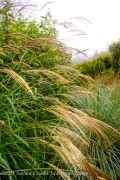
(formerly sold as Miscanthus transmorrisonensis)
Don’t let the clunky name fool you. Of all the Miscanthus, this is the most graceful. Planted en masse, silky silver flowers held on gently arching stems look like water flowing from a fountain of evergreen foliage. As a specimen, it should be planted in a raised area in order to appreciate its weeping form.
Blooms July–November.
Size: 6' 0" – 7' 0" high x 6' 0" – 7' 0" wide.
Hardy to zone 7.
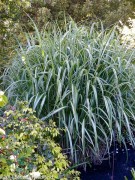
Usher this towering variegated aristocrat into your landscape and a bold statement is yours to enjoy. Wide semievergreen blades feature white streaked margins and green centers with creamy white vertical stripes. Strong stems hurl skyward, supporting the outward arching foliage and, come late summer, they unfurl a sea of silky copper red tassels, eventually maturing to fawn-colored seed heads.
Discovered in Japan during the 1940s, the mighty 'Cosmopolitan' shapes a robust, dense, yet billowy mass that never flops, serves well as a noble specimen, hedge or screen, and rustles delightfully in the wind.
Blooms August – November.
Size: 6' 0" – 8' 0" high x 5' 0" – 7' 0" wide.
Hardy to zone 6.
Gorgeous deep burgundy flower heads that eventually lighten to a creamy chroma, and sparkling silver midribs invigorate ‘Ferner Osten’s dense, arching mass of dark green blades. Introduced by the esteemed German nurseryman Ernst Pagels, this paramount Miscanthus sports a vigorous, yet compact guise that holds its own as a vibrant specimen and looks especially sensational when planted in a drift.
Blooms August–November
Size: 4' 0" – 5' 0" high x 3' 0" wide.
Hardy to zone 6.
Miscanthus sinensis ‘Gold and Silver’ (G-0484)
Each $13.75
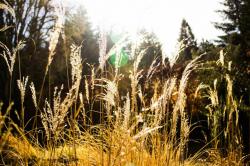
Prepare yourself for a sterling, late season splash as silky plumes glow in golden splendor, and later flaunt sophisticated silvered shades. While narrow blades with prominent midribs sport a pearly sheen and maintain their composure late into the season, this slender beauty stands in sharp relief to a coarse-textured carpet of Trachystemon orientalis at its base.
Blooms September–November.
Size: 5' 0" – 6' 0" high x 3' 0" wide.
Hardy to zone 5.
Miscanthus sinensis ‘Hinjo’ (G-0452)
Each $13.75
Sharing many of the attributes of its larger, better-known relation, Miscanthus ‘Zebrinus’, this preeminent specimen is noticeably smaller. Introduced by Hines Nursery of California, ‘Hinjo’ displays copper-colored blooms and lax foliage with bold yellow stripes in an irregular, horizontal pattern. The bands are set more closely, and especially when viewed from afar, create a spellbinding effect. An excellent option for a garden with limited room, Compact Zebra Grass maintains a good form, and is a high-spirited companion for Rudbeckia triloba ‘Prairie Glow’ and Sedum ‘Mr. Goodbud’.
Blooms September – November.
Size: 5' 0" – 6' 0" high x 3' 0" – 3-1/2' wide.
Hardy to zone 5.
Miscanthus sinensis ‘Kaskade’ (G-0490)
Each $13.75
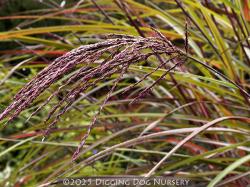
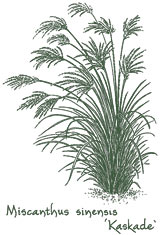
One of the finest summer-blooming Miscanthus, this hearty Ernest Pagels creation draws its namesake from the grand cascading blooms. Rosy colored and large, measuring nearly 10 in. long, the early-to-unfurl inflorescences feature pendent openly arranged branches lolling a good ways beyond the foliage. Narrow leaves don white midribs, while shaping an upright pillar that come autumn blazes coppery reds and finally bleaches to pewter, in perfect harmony with the mature silvery buff racemes. Eupatorium’s reddish purple domes offer contrasting flower shapes and a union of similar colors.
Blooms July–October
Size: 6' 0" high x 3' 0" – 4' 0" wide.
Hardy to zone 5.
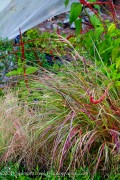
The preeminent plantsman, Ernest Pagels, outdid himself when he bred this exquisite ornamental grass, considered by many to be the most beautiful of the more diminutive Miscanthus. Its merits are numerous: an elegant compact silhouette, early opening rouge-tinged flowers held well above fine-textured blades and excellent cold hardiness. Unlikely to overwhelm its neighbors, Little Fountain Grass ushers impressive arching deep green accents and stylish long-lasting plumes into any planting, especially those short on space.
Blooms July–November
Size: 3' 0" – 4-1/2' high x 3' 0" – 3-1/2' wide.
Hardy to zone 5.
Miscanthus sinensis ‘Little Kitten’ (G-0094)
Each $13.75
Originating as a Miscanthus ‘Yaku Jima’ seedling, ‘Little Kitten’ is a pleasingly bushy mound; its compact form is just right for those who want the drama of ornamental grasses in an intimate setting. Thin, silver-green wiry leaves are decorated in fall by an elegantly spare show of small, silvery plumes. Plant en masse with Eryngium variifolium.
Blooms September–November.
Size: 2' 0" – 2-1/2' high x 18" wide.
Hardy to zone 5.
Esteemed German plantsman Ernest Pagels had a trained eye for making stellar grass selections, and this chromatic cultivar is no exception. Hoisted on thick wine-tinged stems, large, abundant crimped plumes appear early, broadcasting lustrous coppery-purple hues, which eventually lighten to silver. The vigorous rounded clump of broad and lax rich green blades with ash-striped midribs can pose as a picturesque specimen in a mixed border, where its bronze, red and orange fall hues will surely draw attention.
Blooms mid August–November
Size: 5' 0" – 7' 0" high x 3' 0" – 4' 0" wide.
Hardy to zone 5.
Miscanthus sinensis ‘Morning Light’ (G-0011)
Each $13.75
Named by acclaimed plantsman Kurt Bluemel, this fine textured Miscanthus is the epitome of elegance. Long, thin green blades engraved with delicate, vertical creamy white stripes sculpt a rounded habit, which would satisfy even without the feathery pink-blushed panicles lingering just above.
Blooms September–December
Size: 5' 0" high x 3' 0" wide.
Hardy to zone 5.
Miscanthus sinensis ‘Nippon’ (G-0012)
Each $13.75
Deep rosy-violet stems, pinkish plumes and a compact, narrowly upright habit of slightly broader, lush green leaves set this stellar Ernest Pagels selection apart. If you’ve wanted to try a Miscanthus, but are short on space, here’s the plant for you.
Blooms August–November
Size: 4' 0" high x 2' 0" wide.
Hardy to zone 5.
Miscanthus sinensis ‘Positano’ (G-0491)
Each $13.75
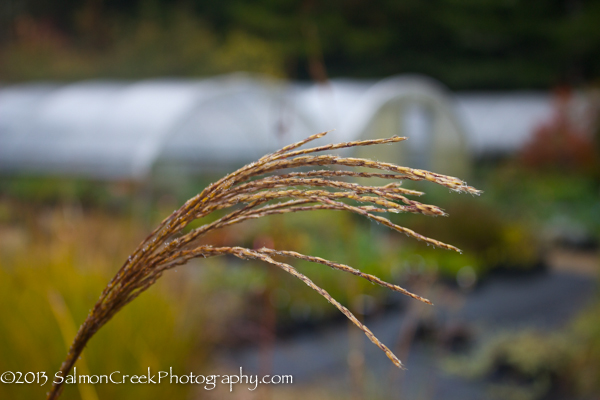
A graceful standout, ‘Positano’ warms the fall landscape with sunkissed colors. Large, red, glistening plumes are cast well above the impressive upright fountain of arching, fine textured blades. Etched by pewter midribs, the foliage grows in a sophisticated crisscross pattern and when fall arrives, transmutes toasty reds and oranges.
Revered grass aficionado Ernst Pagels raised this clump-forming cultivar whose first-class profile and rich hues can accentuate Rudbeckia ‘Goldquelle’ and Helianthus ‘Capenoch Star’.
Blooms August–November.
Size: 6' 0" – 7' 0" high x 3' 0" – 5' 0" wide.
Hardy to zone 5.
Miscanthus sinensis ‘Rigoletto’ (G-0485)
Each $13.75
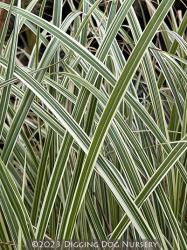
If your garden has limited room, ‘Rigoletto’ is a brightly patterned treasure that you’ll want to squeeze in. More compact and smaller growing than ‘Variegatus’, this Kurt Bluemel introduction parades slender blades inscribed with gleaming white vertical stripes. Topped by red-tinged flowering plumes, the loose nimbly flowing clump vows dramatic ivory-toned highlights for the landscape or for a glazed cobalt-blue container.
Blooms August–November
Size: 3' 0" – 4' 0" high x 2-1/2' – 3' 0" wide.
Hardy to zone 5.
Miscanthus sinensis ‘Rotsilber’ (G-0041)
Each $13.75
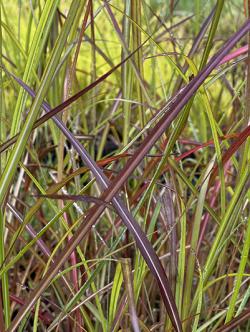
Aptly named, ‘Rotsilber’ translates “red and silver,” which denotes the showy flowers’ intriguing evolution. Emerging crimped and flushed in lustrous red tones atop green and wine-tinted stems, the plumes later attain a silver splashed, soft fluffy appearance. Ernst Pagels introduced this impressive upright selection whose slim and compact, energetic green blades are enhanced by steel-hued midribs and passionate orange and maroon fall colors, forging a stately stand-alone specimen for the mixed border or a more untamed locale.
Blooms August – November.
Size: 4' 0" – 5' 0" high x 3' 0" wide.
Hardy to zone 5.
Miscanthus sinensis ‘Sarabande’ (G-0013)
Each $13.75
‘Sarabande’ really puts on a show with sprays of blush-hued flowers that emerge straight as arrows, then open looking freshly crimped and fade to silver. Graceful, swaying stems and a fine flourish of foliage complete the three-tiered effect. The variegated leaf blades have an olive cast that harmonizes nicely with silver and gray-foliaged plants. We’ve seen ‘Sarabande’ maintain its composure through the worst of coastal gales.
Blooms August-December.
Size: 5' 0" – 6' 0" high x 3' 0" wide.
Hardy to zone 4.
Miscanthus sinensis ‘Silberturm’ (G-0492)
Each $13.75
Coined ‘Silver Tower’, this kingly cultivar is the best tall growing Miscanthus we know. Asserting a BIG and bold grandeur in the landscape, the lush column of long broad foliar ribbons, which arch out and down in a lax manner, gracefully rises heavenbound. Large, loosely arranged silver plumes shimmer when they catch the sun nearly 10 spectacular feet above us.
Whether it’s mixed with tropicals, framing a threshold or premiered as a towering specimen, the magnificent ‘Silberturm’ exhibits a fine form all season and will surely turn quite a few heads.
Blooms August–November.
Size: 8' 0" – 9' 0" high x 5' 0" – 6' 0" wide.
Hardy to zone 6.
Miscanthus sinensis ‘Strictus’ (G-0015)
Each $13.75
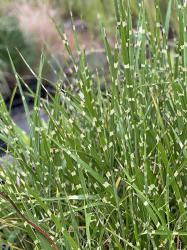
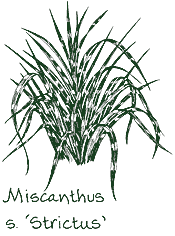
Sharing many of the attributes of its more common relation, Zebra Grass, this artful specimen is a bit denser, stiffer and more upright. Beautifully at home by water’s edge, ‘Strictus’ displays chestnut-hued blooms and lax foliage with bold blond-colored stripes in an irregular, horizontal pattern. When viewed from afar, the warm bands create a spellbinding effect. Porcupine Grass maintains a good form, and makes a high-spirited companion for Bergenia ‘Bressingham White’ and Sedum ‘Matrona’.
Blooms August–November
Size: 6' 0" – 8' 0" high x 3-1/2' – 4-1/2' wide.
Hardy to zone 5.
Miscanthus transmorrisonensis (G-0478)
Each $13.75
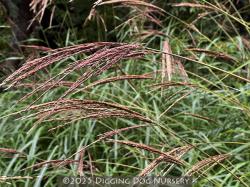
Don’t let the clunky name fool you. Collected from seed at 9500 ft. on Taiwan’s Mount Daxue by Paul Meyer and C. Ferris Miller and introduced in 1979, this is the most shapely of all the Miscanthus. Pendent, silky silver flowers, held on long, gently arching stems, lounge above a flowing base of narrow, glossy green foliage. This clumping grass remains evergreen in warmer climates and can be positioned as a lone specimen, but best shows its low weeping profile and artful beauty when massed, in a raised area or on a slope with Helianthus ‘Santa Fe’ and Aster ‘Raydon’s Favorite’ nearby.
Blooms April–November
Size: 4' 0" – 5' 0" high x 4' 0" – 6' 0" wide.
Zone 6b.
Molinia
Moor Grass
Innovative landscape architect Wolfgang Oehme, who included more than a million ornamental grasses in his designs, considered Molinias to be some of the very best performers of them all. Certainly the most kinetically exciting grass, Molinia’s dense arching tufts of deep green foliage offer sturdy stems holding delicate panicles that eventually age to a straw color and last for months. To heighten the drama, consider providing plenty of room and a dark background.
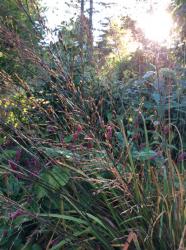
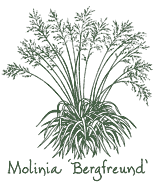
Invite this “friend of the mountain” into your garden bed and it will quickly become your friend as well. Dynamic yet not too imposing, a gauzy array of gently pendulous, rich-colored reddish purple flowers mingles on upright dark green stems. Handsome foliage forms a low green stage that radiates yellow hues in autumn. Studded with rice-like beads transmuting warm chestnut shades when mature, the airy plumes should be headlined right up front where they become a mysterious mist that you can peer through.
Blooms June–October
Size: 4' 0" – 5' 0" high x 3' 0" wide.
Hardy to zone 4.
A boldly architectural grass thought to be one of famed plant breeder Ernest Pagel's last selections, 'Cordoba' stands nearly 7 ft. tall, a monolithic beacon of dramatic proportions. Noble green blades construct the substantial moderately upright leafy mound, releasing gently arching erect stems and sheer purple-hued seed heads. Its enticing shades of yellow herald autumn with sunshine- soaked leaves and butterscotch-colored waning inflorescences. Recently rediscovered and introduced by Intrinsic Perennial Gardens, this vigorous easily cultivated Molinia relishes cool moist conditions, appreciates additional water during hot spells, makes a statuesque stand-alone and steals the show when massed.
Blooms June–November
Size: 6' 0" – 7' 0" high x 3' 0" wide.
Hardy to zone 5.
See-through, delicate plumes on upright and arching stems energetically leap skybound from a green, 2-½ ft. tall foliar pedestal. Bearing the name of the legendary German nurseryman Karl Foerster, this Molinia’s gossamerlike inflorescences first emerge suffused in purply raisin shades, and by fall gilded highlights set the lofty blooms aglow, further heightening the butter yellow hues of the stalks and leaves below.
Blooms June – October
Size: 6' 0" – 7' 0" high x 3' 0" wide.
Hardy to zone 4.
Donning a stately sculptural habit and a dancer’s grace, especially when roused by summer breezes, this first-class Kurt Bluemel selection grows narrowly upright. The pendulous grayish green ribbons comprise a low, 2 ft. high, mounding clump that launches firm stems with plum-colored seed heads and feathery, veil-like panicles. Still compelling in November, both foliage and lofty inflorescences adopt cozy golden-yellow and amber fall colors.
Blooms June–November
Size: 7' 0" – 8' 0" high x 3' 0" wide.
Hardy to zone 4.
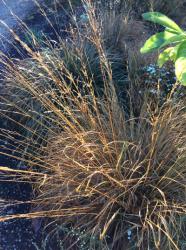
Dark green ribbon-like blades and golden fall color distinguish ‘Staefa’s spiffy 2 to 3 ft. tall mound that debuts a bounty of stiff-stemmed predominately upright airy panicles. Named after a lakeside Swiss city, this stately Molinia can edge a trail, be planted mid-border or viewed from afar, where its captivating fine textured blooms promise a graceful visual feast, either glowing in the afternoon sun, waltzing with the wind or accompanying Sedum ‘Septemberglut’ and Filipendula ‘Venusta Alba’.
Blooms July–October
Size: 4' 0" – 5' 0" high x 3' 0" wide.
Hardy to zone 4.
Sporting a peerless upright profile, the narrow vase-shaped habit of neat, thin green blades gives way to erect stems laden with greenish purple flower spikelets. Misty-looking inflorescences offer beguiling glimpses of what lies behind, while maize-colored foliage signals autumn. Heather Bride’s striking vertical aspect can be positioned in the rockery, massed in a natural setting or planted as a counterpoint amid smaller more lax-looking plants.
Blooms June–November
Size: 2-1/2' – 4' 0" high x 2' 0" – 3' 0" wide.
Hardy to zone 5.
An exquisite German selection of Moor Grass, this Molinia’s wispy, flaxen-hued inflorescences nimbly prance on 2 ft. slender stems above a pleasing, compact clump of arching and slender green blades. ‘Moorflamme’ turns a vivid orange-red in autumn and clearly proclaims its colorful intensity.
Blooms June–October
Size: 4' 0" high x 2' 0" wide.
Hardy to zone 4.
Likened to poetry in motion when a lazy wind stirs, stiff slender stems rise well above widely arching compact blades, bowing under the weight of large, fine textured, hazy purple blooms. Ideal for small-scale gardens, the neat slim green leaves and stalks are shorter than our other Molinia selections, and come fall their lambent golden-yellow hues invigorate the landscape. This first-rate dwarf cultivar projects a broad light-footed stance that partners well with the magenta flowers of willowy Dianthus carthusianorum.
Blooms July–November
Size: 2' 0" – 3' 0" high x 2' 0" – 3' 0" wide.
Hardy to zone 5.
Molinia caerulea ‘Dauerstrahl’ (G-0531)
Each $13.00
The cultivar name translates to “enduring ray” for the long-lasting beauty this fine textured grass bestows upon the garden. Prancing above robust low growing tufts of emerald-green foliage, stiff mostly upright divergent stems showcase elegant panicles with slim dark purple spikelets. ‘Dauerstrahl’ is second-to-none as a container specimen or as a mixed border component, adding late season allure when bright buttery yellow hues transform its blades and flowering stalks.
Blooms June–November
Size: 3' 0" – 4' 0" high x 2' 0" – 2-1/2' wide.
Hardy to zone 4.
This tailored close-knit clump unleashes a bounty of dense wand-like panicles atop erect and divergent, sturdy green stems with mahogany stains. Showcased to great effect above the linear, grass-like medium green leaves, narrow, lanky deep green flower heads develop dramatic damson hues by late summer, while penny and biscuit tones warm the entire plant once the weather cools down. Maintaining her stylish vase-shaped silhouette well into winter, ‘Edith Dudszus’ can be ensconced anywhere tactile, vertical or kinetic elements are welcome.
Blooms July–November
Size: 2-1/2' – 4' 0" high x 2' 0" – 2-1/2' wide.
Hardy to zone 4.
Molinia caerulea ‘Moorhexe’ (G-0049)
Each $13.00
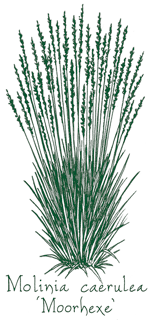
This easily maintained cool season grass projects formal straight-up accents with its tidy, narrow shaft of taut, slim green blades topped by needle-thin flower stems. Populating open gossamer-like panicles, the spiky dark purple inflorescences yield plum-brown seed heads, a stunning complement to the saffron-hued autumn foliar tones. Second-to-none for seaside or prairie schemes, a border, rockery or gravel garden, ‘Moorhexe’s compelling vertical silhouette effectively offsets lower growing plants like Potentilla atrosanguinea and Aster ‘Dream of Beauty’.
Blooms July–November
Size: 2' 0" – 3' 0" high x 18" – 2' 0" wide.
Hardy to zone 4.
Selected by Piet Oudolf and named for the famed Danish nurseryman, this sturdy AGM victor earned a 4-star rating from the Chicago Botanical Garden’s Molinia trials. Feathery inflorescences with petite green and purple flowers on lithe upright stalks prance above the low-growing vase-shaped clump of close-knit, slightly flexed green blades. Roused by a golden copper-hued fall finale, quibble-free ‘Poul Petersen’s attractive bushy visage can be massed in natural-style venues amid chums like Aster ‘Bluebird’ , Echinacea ‘Magnus Superior’ and Sanguisorba ‘Morning Select’, relishing sun, good drainage and adequate moisture.
Blooms July–November
Size: 3' 0" – 3-1/2' high x 3-1/2' – 4' 0" wide.
Zone 4b.
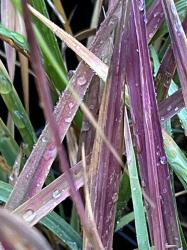
Long admired for its low growing, closely knit foliage, unique purple coloration and wispy-topped, wide-splayed flowering stems, this handsome, color-rich Molinia sprung forth as a chance seedling in one of Digging Dog Nursery’s display borders. Midsummer finds the neat, flowing green foundation infused with damson-plum hues, while firm, lean, arching stems turn purple, eventually broadcasting lavish raisin shades and glittering copper-colored seed heads in autumn. An opulent see-through specimen, ‘Purple Infusion’ can be showcased right up-front, accompanied by Clematis ‘Polish Spirit’, Eupatorium ‘Riesenschirm’ and Phlox ‘Nicky’.
Blooms June–October
Size: 3' 0" – 4' 0" high x 3' 0" – 4' 0" wide.
Hardy to zone 4.
Molinia caerulea ‘Transparent’ (G-0018)
Each $13.00
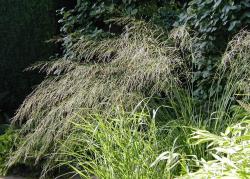
As moisture settles on ‘Transparent’s soft floral haze, umpteen, minute loosely spaced purple seed heads evoke an exquisite piece of lace. The low, well-groomed mound of ribbon-like green blades gives way to tall, ultrafine arching stalks plus unbranched inflorescences that linger high above the leaves. Swayed by the slightest breeze, this easily grown Molinia’s flowers furnish a sophisticated purple-tinged transparency near summer’s end, while gilded tones imbue the entire plant when cooler nights arrive. It can be massed in a naturalized setting or reside midborder with Vernonia ‘Iron Butterfly’ and Aster turbinellus nearby.
Blooms July–November
Size: 5' 0" – 8' 0" high x 2' 0" – 3' 0" wide.
Hardy to zone 5.
Applauded as one of the choicest variegated grasses, close-knit rounded tufts produce flat, slender arching green leaves with vibrant creamy-white and pale yellow longitudinal stripes. Countless gauzy buff and purple-hued flowers on slightly curving 2 ft. stalks sashay above ‘Variegata’s versatile habit that beams glowing golden foliage for autumn. This diminutive AGM recipient can be featured as a beguiling specimen or en masse in mixed borders, cottage gardens and at water’s edge, where it appreciates moist niches, dappled light and protection from hot afternoon sun.
Blooms July–October
Size: 2-1/2' high x 2-1/2' wide.
Zone 4/5.
Molinia litoralis ‘Windspiel’ (G-0019)
Each $13.00
The cultivar name is German for wind’s game and this grass plays against the sky. Stretching far above mounding 15 in. high, verdant ribbonlike blades, supple stems entertain an aura of tiny copper-colored inflorescences. We position ‘Windspiel’ in the frontlines and plant bold perennials such as Helianthus ‘Gold Lace’ or Vernonia crinita behind to enjoy the subtle other worldliness that’s created by looking through its blooms.
Blooms June–October
Size: 6' 0" – 7' 0" high x 5' 0" wide.
Hardy to zone 4.
Muhlenbergia
Muhly
Named in honor of G. H. E. Muhlenberg, a botanist who specialized in grasses, this large, varied genus includes some of the most visually stunning and enduring ornamental grasses for today’s landscape. Primarily native to arid range areas of the southern U.S. and Mexico, many Muhlenbergias boast not only arresting inflorescences and foliage, but an exceptional tolerance to heat, sun and drought, plus limited amounts of dappled shade each day, as long as the soil has sharp drainage.
Muhlenbergia capillaris (G-0057)
Each $12.50

Holding their attraction for months, ethereal masses of airy flower panicles are imbued in vivid pinkish red tones, which age to a light buff. This plush mist hovers atop a fine textured, semievergreen clump of polished dark green foliage. With an unmatched vivacity, particularly when planted in drifts, the Pink Muhly will easily bridge the gap from a cultivated garden space into the native habitat.
Blooms September–early December
Size: 3' 0" high x 3' 0" wide.
Hardy to zone 6.
Muhlenbergia capillaris ‘Pink Cloud’ (G-0572)
Each $12.50
Slender, smooth glossy green blades, which appear nearly identical to the species, cushion a spectacular long-lasting delicacy of finely branched vibrant pink panicles. Countless minute seed heads lend a dreamy soft-looking aspect, drawing plant aficionados as well as birds and floral arrangers. Assuming a dogged, drought-tolerant evergreen habit, ‘Pink Cloud’ is ideal for planting in sweeps, singularly or in containers.
Blooms September–early December
Size: 3' 0" – 4' 0" high x 2' 0" – 3' 0" wide.
Hardy to zone 6.
Muhlenbergia capillaris ‘White Cloud’ (G-0507)
Each $12.50
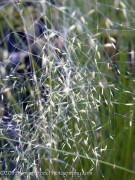
In an illuminated departure from the native species, the delicately branched nearly transparent panicles spawn a white wispy mass along the upper reaches of sleek, dark green blades. With cloud-like inflorescences that brighten the garden well after the first frosts, this orderly clumping Muhly is both splendid and stalwart and can be effectively utilized as a specimen.
Blooms September–early December
Size: 3' 0" high x 3' 0" wide.
Hardy to zone 6.
Each $12.50
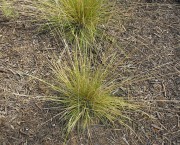
This small-scale architectural gem celebrates a finely cut impeccably shaped green mound. Half the size of its taller relative, Muhlenbergia rigens, Pine Muhly's dense mostly evergreen clump of upright narrow cylindrical blades bolsters slim purple-tinged plumes, which blanch to almond shades on rigid, 2 to 3 ft. tall skinny stems. Roaming the higher altitudes of the Chihuahuan desert in west Texas, New Mexico and northern Mexico, Muhlenbergia dubia is undaunted by heat and drought, enjoys sharply drained sites and brings untold elegance to a patio vessel, mass planting or a tight spot.
Blooms August – October
Size: 2' 0" – 3' 0" high x 2' 0" – 3' 0" wide.
Hardy to zone 7.
Each $12.50
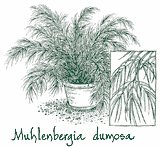
Noted for its extraordinary fine texture and striking resemblance to bamboo, this warm season grass conveys a lighthearted grace. Delicately branched, upright and arching supple stems and thin light green leaves define the billowy mass that forms a noninvasive clump, preferring occasional water while enduring deer, heat and drought.
Stirring in just about any breeze, the evergreen Bamboo Muhly hails from Arizona and southern Mexico, produces insignificant pale pink flowers and is destined to become an airy counterpoint to Yucca ‘Garland’s Gold’s bold blades or where winter’s are cold, an ethereal container subject.
Blooms May
Size: 3' 0" – 6' 0" high x 3' 0" – 4' 0" wide.
Hardy to zone 7.
Muhlenbergia lindheimeri (G-0104)
Each $12.50
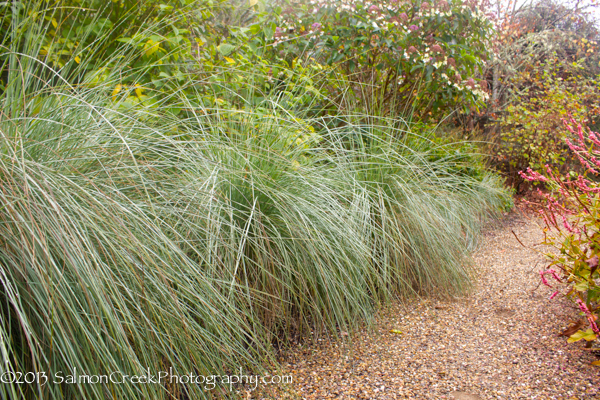
Lanky, open Calamagrostis-like panicles are colored in muted purplish gray tones, aging to an antique silver that festoons the winter landscape. The rounded refined-looking clump of semievergreen blue-gray foliage sends forth slender, perfect-for-cutting inflorescences on upright 2 ft. tall stems. Whether headlined as a sophisticated stand-alone or massed, this sensational Muhlenbergia delivers tranquil hues and a tidy durable visage.
Blooms September–December
Size: 5' 0" high x 2' 0" wide.
Hardy to zone 7.
Though the species is indigenous to the limestone outcroppings of northern Texas and southwestern Oklahoma, this amazing seed strain was collected near Fort Worth, TX by Lauren Springer and Scott Ogden, and subsequently introduced by Colorado’s Plant Select program. A small growing, warm season grass, Ruby Muhly’s fine-hewn green blades form a long-lived dense tussock beneath spectacular gauze-like reddish mauve inflorescences that appear earlier and are less pink than Muhlenbergia capillaris. Undaunted pretty much sums it up—the tailored compact habit performing heroically in cold, drought, heavy clay, sweltering heat and southern humidity. Warm tawny-brown winter interest coupled with an easy-care en masse presence make it indispensable.
Blooms August–October
Size: 2' 0" – 3' 0" high x 18" – 2' 0" wide.
Hardy to zone 5.
Each $12.50
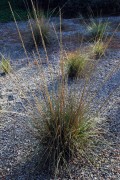
A long-time resident of California and other southwestern states, this semievergreen Muhlenbergia yields upright, thin and arrowlike silvery inflorescences reaching beyond the narrow, 18 in. high gray-green foliage. Creating a shimmery veiling effect in the landscape and adding pizzazz to dried arrangements, the reflective flowering stalks bend gracefully as they age.
Let Deer Grass weave its way around the contrasting horizontal form of Arctostaphylos ‘Vancouver Jade’, or superimpose it against Lobelia tupa.
Blooms September–December
Size: 5' 0" high x 4' 0" wide.
Hardy to zone 7.
Panicum
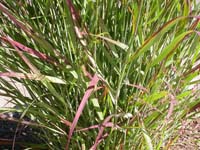
Switch Grass
Our Panicums are warm season prairie grasses native to North America. Resistant to heat, drought and extreme cold, Switch Grass hosts a cloud of inflorescences—a mystifying hologram of tiny red seeds that mature to black in late summer. If grown in drifts and not cut back until early spring, Panicums promise a lively winter show. After several frosty nights, they stiffen and adopt the warm glowing color and soft rustling sound of wheat.
Populating Delaware’s coastal sand dunes near the town of Dewey, noted grass expert, Rick Darke selected this kingly Panicum for its blue, oh-so-blue smooth glaucous blades and elegant fountainlike stance. Distinctive straight-up stems bolster light airy plumes, followed by caramel-colored seed heads persisting well into winter. ‘Dewey Blue’ is not only a stunning showman but an enduring workhorse whose slowly spreading rhizomes form clumps that are vital in stabilizing seashore ecosystems, as well as withstanding hot dry summers and varied garden soils.
Blooms August – October.
Size: 4' 0" – 5' 0" high x 3' 0" wide.
Hardy to zone 3.
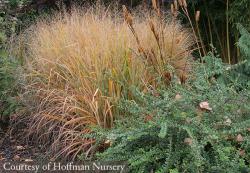
Conjuring early morning summer skies, a thick light-catching haze of hushed pink inflorescences hovers just above broad bluish green blades that forge a compact upstanding foundation. This tailored grass earns its keep with rosy-gilded fall color, persistent bird-friendly seed heads and a versatile guise that abides drought, varied soil types, coastal conditions and pollution. Discovered at North Carolina’s Hoffman Nursery, ‘Summer Sunrise’ adds pizazz to mixed borders, rain gardens, ecological plantings and cut arrangements.
Blooms August–October
Size: 3-1/3' – 4-1/2' high x 18" – 2' 0" wide.
Hardy to zone 4.
Panicum virgatum ‘Cape Breeze’ (G-0565)
Each $13.00
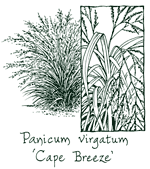
Hats off to North Creek Nursery for this exceptional new Panicum that combines sensational good features with a brawny tough-as-nails temperament. Beneath copious gauzy looking amber-hued seed heads, trim ribbons of upright greenery retain their color ’til November, then transmute buttery yellow shades. Beloved by birds, butterflies, florists and horticulturalists, ‘Cape Breeze’ lauds early blooms plus a no-coddle compact habit, forbearing deer, disease, dry conditions and salt spray. (PP#24,895)
Blooms July–October
Size: 2' 0" – 2-1/2' high x 20" – 2' 0" wide.
Hardy to zone 4.
Panicum virgatum ‘Cloud Nine’ (G-0082)
Each $13.00
It’s not sky high, but ‘Cloud Nine’ does impart visions of grandeur as it rises into a massive, somewhat vase-shaped, blue-green form crowned by a mist of small inflorescences. Autumn brings golden tones to the foliage. This Panicum usually maintains its elegant shape through tough winter months, and is a dynamic partner with Salvia confertiflora for the rest of the season.
Blooms August–October.
Size: 6' 0" – 8' 0" high x 3' 0" wide.
Hardy to zone 4.
Panicum virgatum ‘Heavy Metal’ (G-0021)
Each $13.00
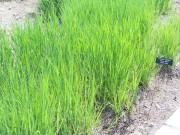
One of the most upright of the blue-leafed varieties, this Kurt Bluemel selection struts glaucous gray-blue foliage beneath airy pink-tinged blooms. Autumn brings warm pecan-brown hues to ‘Heavy Metal’s vertical stance, which looks especially dynamic when planted in swaths.
Blooms September–October
Size: 4' 0" – 5' 0" high x 3' 0" wide.
Hardy to zone 5.
This colorful, smaller statured Panicum makes its way into plenty of European gardens, but is sadly hard to find here in the states. Airy clusters of pinkish oat-colored inflorescences traipse upon firm upright stalks cloaked with dapper, glaucous bluish green blades that manifest rousing deep burgundy tones once the nights turn cool. A staunch versatile grass, ‘Heiliger Hain’s manageable size makes it well-suited for midborder positions, decorative containers or swathes in larger spaces.
Blooms July–October
Size: 4' 0" high x 2' 0" – 2-1/2' wide.
Hardy to zone 5.
Panicum virgatum ‘Northwind’ (G-0544)
Each $13.00
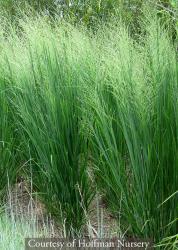
Claiming the coveted 2014 Plant of the Year award, ‘Northwind’s roots can be traced back to the railroad tracks near South Elgin, IL, where Roy Diblik collected some native Panicum seeds. Selected from those initial seedlings for its unique unwavering stature, this dashing straight-backed cultivar unleashes a narrow sky-bound clump of broad olive-colored blades with bluish green undersides. The gossamer textured inflorescences hover just above the leaves and are characterized by tiny yellow flowers plus purple seed heads. Unsung among ornamental grasses and the most markedly vertical of the Switch grasses, it lends intriguing winter architecture and possesses a tenacious bent that triumphs over drought, heavy downpours, varied soil conditions, pesky deer and foliar rust.
Blooms August–October
Size: 4' 0" – 6' 0" high x 2' 0" – 2-1/2' wide.
Hardy to zone 5.
Panicum virgatum ‘Prairie Sky’ (G-0080)
Each $13.00
The bluest of the Panicums and hardiest of the virgatums, this superb selection was discovered growing wild in a Wisconsin meadow by Roger Gettig. Its silvery inflorescences have tiny rust-colored accents, and 'Prairie Sky's fast growing foliage spawns a cool blue fusion when associated with Yucca 'Sapphire Skies' and Eryngium 'Big Blue'.
Blooms July - October.
Size: 3' 0" – 5' 0" high x 2-1/2' wide.
Hardy to zone 4.
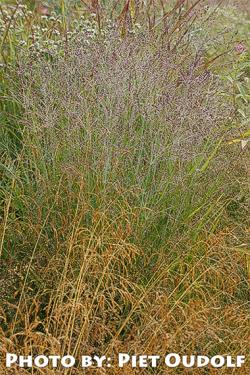
Famed designer and plantsman Piet Oudolf discovered this superb new Panicum growing in his personal garden. A probable Panicum ‘Shenandoah’ offspring, ‘Purple Tears’ premiers an alluring aura of smoky gray-tipped flowering spikes studded with bead-like purple seed heads. All this eye-catching violet intrigue lingers above natty medium green blades, furnishing an upright, somewhat narrow habit that promises grace, versatility and resilience plus warm red-orange autumnal hues. (pp#28,518)
Blooms August–October
Size: 4' 0" high x 2' 0" – 2-1/2' wide.
Hardy to zone 4.
Panicum virgatum ‘Rehbraun’ (G-0558)
Each $13.00
Prized for fantastic autumn color and impressive vertical accents, a narrow upstanding clump fashions slender grayish green leaves that broadcast dark maroon and violet shades in late summer. The dreamy cloud of finely cut haze-like purple-green spikelets bleaches to beige and persists into winter, while the compact long-lived foliar column wears a buff-tinged cold-weather coat. Abiding drought, wet conditions, clay and erosion, this popular all-purpose native can enhance a stylized meadow or mixed planting, either massed or as a specimen, and hobnob with fellow natives like Eupatoriums and Helianthus.
Blooms July–October
Size: 3' 0" – 4' 0" high x 2' 0" – 2-1/2' wide.
Hardy to zone 5.
Panicum virgatum ‘Rotstrahlbusch’ (G-0059)
Each $13.00
This exceptional vintage cultivar has withstood the test of time, touting the smallest, most upright foliar foundation with the brightest most enduring red blades of all our Panicum. Suave, fine textured silver-green blades, subtly blushed in late spring, ascend vertically and cushion a lovely diaphanous mass of branched pink-tinged flower panicles. “Red Ray Bush”, as it translates from German, begins broadcasting passionate fiery red foliage in August that ignites the late season border, while companions such as Aster ‘Raydon’s Favorite’, Sedum ‘Mr. Goodbud’ and Kniphofia ‘Yellow Cheer’ inject complementary color.
Blooms July–October
Size: 4' 0" – 5' 0" high x 2' 0" – 2-1/2' wide.
Hardy to zone 5.
Celebrating long-lasting appeal and color galore, this exceptional Panicum ‘Heavy Metal’ and Panicum ‘Hänse Herms’ cross was chosen by Dr. Mark Brand from the University of Connecticut. Fantastic arching ribbons of foliage initially emerge in soft gray-greens, then in early summer, transmute a vibrant ruby-red, which heightens as the season progresses. Loosely arranged, broad tapered blades forge an upright textural clump renown for its unparalleled, richly hued fall finale, while hazy sand-colored inflorescences create winter interest, especially when overlaid with frost or snow. (pp#17,944)
Blooms August–November
Size: 3' 0" – 4' 0" high x 2' 0" – 2-1/2' wide.
Hardy to zone 4.
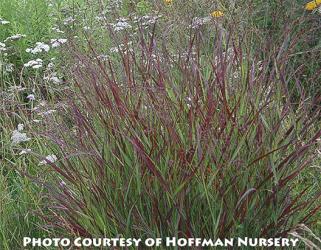
One of the best of the red Panicums, ‘Shenandoah’ was selected from ‘Hänse Herms’ seedlings by Germany’s Hans Simon. The slender green leaves exhibit maroon hues in midsummer, and come September are thoroughly transformed. Paired with Sanguisorba ‘Red Thunder’ the wine-infused theme is echoed, and backlit by the long light of late afternoon, the glow is ethereal.
Blooms August–October
Size: 4' 0" high x 2' 0" – 2-1/2' wide.
Hardy to zone 4.
The mighty brainchild of Michigan nurseryman Gary Trucks, this easy-care Panicum ‘Cloud Nine’ and Panicum ‘Northwind’ hybrid soars to lofty heights. Crowned by misty pinkish tan panicles, steadfast broad blue-green blades compose an upright and slightly arching, 8 ft. profile that swaggers a magnificent bearing even in winter, remaining tall through wind, heavy rain and snow. ‘Thundercloud’s handsome bird-friendly foliage and open blooms can grace a vase, flank a mixed border, serve as a screen, or stand-alone as a stately specimen in a stylized meadow. (pp#20,665)
Blooms August–October
Size: 7' 0" – 8' 0" high x 3' 0" – 4' 0" wide.
Hardy to zone 4.
Panicum virgatum ‘Trailblazer’ (G-0076)
Each $13.00
Selected from the native prairie grasses of the Midwest for its larger, showier seed heads, this graceful new cultivar has a long list of admirers, including several butterfly species. Sheer red-tinted flower clusters wave good-bye to summer as blue-green blades flaunt a blaze of old golds and maroons that promise to brighten your autumn and maintain a winter presence.
Blooms September – October.
Size: 4' 0" – 5' 0" high x 2' 0" – 3' 0" wide.
Hardy to zone 5.
Panicum virgatum ‘Warrior’ (G-0034)
Each $13.00
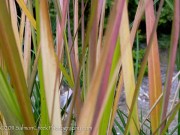
The cultivar name of this grass alludes to the blood red hues of the blades and to its strong growing power. Upright and arching, ‘Warrior’s inflorescences rise to 5 or 6 ft., as its red foliar hints intensify through the early season, turning deep reddish brown in late fall and eventually fading to the color of creamed honey. For an army of rosy color, plant with other grasses like Pennisetum orientale.
Blooms August–October.
Size: 5' 0" – 6' 0" high x 2' 0" – 3' 0" wide.
Hardy to zone 5.
Pennisetum
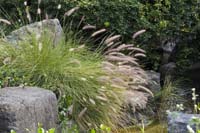
Fountain Grass
The soft inflorescences take their name from the Latin words penna and seta meaning feather-bristle. This alluring grass is a favorite, distinguished by arching, feathery bottlebrush flowers spilling over a cascading mound of foliage. A warm season grower, Fountain Grass welcomes hot weather and is widely distributed in both tropical and temperate areas.
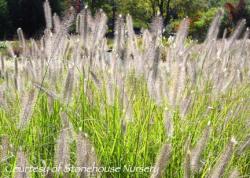
Standing taller than most alopecuroides species, this spectacular Kurt Bluemel selection has a lot to brag about besides its inherent good looks: no stray seedlings, exceptional vigor and reliable longevity. Narrow green foliage defines the large upright fountain-shaped clump that’s topped with a fuzzy 5 ft. high gathering of tan-colored inflorescences. Aptly named, ‘Foxtrot’ dances to the slightest breeze with late-blooming perennial cohorts such as Phlox ‘Jeana’, Helianthus ‘Lemon Queen’ and Gaura ‘White Heron’.
Blooms late July–October
Size: 5' 0" high x 4' 0" wide.
Hardy to zone 5.
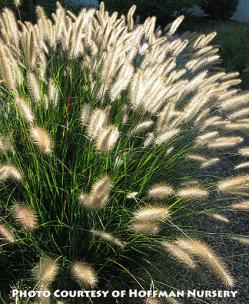
Honoring German horticulturist Cassian Schmidt, this graceful midsized Kurt Bluemel selection sparks our interest through 3 seasons. Its compact fluid form sets the stage for fawn-colored bristle-like cylinders that softly linger just above elegant foliar blades. In a grand finale of arresting warmth, the autumnal leaves celebrate lavish gilded highlights and red hues, which earn ‘Cassian’ a front row seat in our mixed border.
Blooms August?October
Size: 3' 0" high x 2-1/2' – 3' 0" wide.
Hardy to zone 6.
Pennisetum alopecuroides ‘Ginger Love’ (G-0589)
Each $13.00
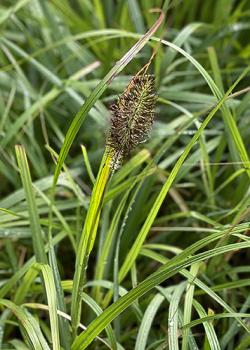
Adored by birds, floral designers and grass enthusiasts, a plethora of long, thick, dark reddish purple blooms softens ‘Ginger Love’s graceful mounding habit. The substantial bottlebrush-like inflorescences put on a fluffy late summer gala above narrow flowing green blades that signal autumn with warm coppery-bronze hues. This Intrinsic Perennial Gardens’ introduction develops a smaller clump than Pennisetum ‘Red Head’ and can be readily nudged into plantings where space is a premium, lending textural accents to containers, rockeries, mixed borders and water garden peripheries. (pp#26,442)
Blooms August–October
Size: 2' 0" – 3' 0" high x 2' 0" – 3' 0" wide.
Zone 5/6.
Pennisetum alopecuroides ‘Hameln’ (G-0465)
Each $13.00
Its compact habit and fine textured foliage make this one of the most popular Pennisetum cultivars. The foliar mound is very upright and dome-shaped, hosting blades that are darker than most Pennisetum alopecuroides. Appearing earlier than others in the species, a slew of plump woolly, slightly curved, creamy-green flower heads, arching at least a foot aloft, are borne on wiry slender stems. To heighten your garden drama, let ‘Hameln’ anchor a riot of Asters and Nepetas.
Blooms late July–October
Size: 2' 0" – 2-1/2' high x 2-1/2' wide.
Hardy to zone 6.
Pennisetum alopecuroides ‘Moudry’ (G-0453)
Each $13.00
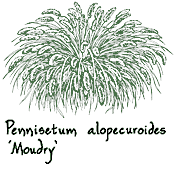
Brimming with fairly wide, glossy deep green foliage, ‘Moudry’ forms a burnished, tidy-looking basal mound. The captivating bushy spikes resemble large dense foxtails, as they rise on stiff stalks just above lush deciduous leaves, which color to yellow and orange come autumn. Second-to-none among ornamental grasses, the fuzzy blooms impart dark purple-black shades, and make phenomenal cut flowers, fresh or dried. Introduced by the National Arboretum from a batch of Japanese seeds, fall-blooming Black Fountain Grass is unbeatable for its late season appeal in the landscape.
Blooms September–November
Size: 2' 0" high x 2' 0" – 2-1/2' wide.
Hardy to zone 6.
If you are looking for a perfectly sized Pennisetum that’s loaded with fleecy blooms and doesn’t require much care, this new cultivar may be your answer. Though ‘Piglet’ is small-statured, about half the size of Pennisetum ‘Hameln’, it’s certainly not the runt of the litter, growing taller and more substantial than ‘Little Bunny’. Easy to tuck into a tight, well-drained space amid Aster asperulus and Astrantia ‘Buckland’, the long-lived, fine textured green foliage supports a light-as-air profusion of cylindrical tawny-colored blooms. (pp#19,074)
Blooms August–October
Size: 18" high x 18" – 2' 0" wide.
Zone 5/6.
Pennisetum alopecuroides ‘Red Head’ (G-0566)
Each $13.00
Selected by Intrinsic Perennials’ owner, Brent Horvath, ‘Red Head’ bolsters wondrous quantities of deep purple buds and huge, furry bottlebrush-like muted violet plumes, some 9 in. long and 3 in. wide. The stylish long lasting inflorescences appear earlier than most alopecuroides above a rounded arching green fountain. Projecting a tailored appearance throughout the season, which brightens autumn with golden yellow hues, this Pennisetum ‘National Arboretum’ offspring can be planted in drifts for kinetic drama or utilized as a marvelous color-rich specimen amid perennials.
Blooms September–November
Size: 4' 0" high x 4' 0" wide.
Hardy to zone 5.
Pennisetum ‘Fairy Tails’ (G-0523)
Each $13.00
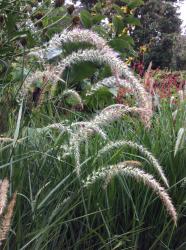
Described by a definitive architectural silhouette, this possible Pennisetum incomptum seedling sprung up in the Pomona Nursery of noted grass enthusiast, John Greenlee. Erect, light pink tapering “tails˝ on upright stems attain delightful deep wheat colors when mature, appearing somewhat denser and not as airy as other Pennisetum species. The attractive semievergreen clump of refined gray-green blades withstands both heat and drought, and brings prominent vertical elements to Stipa gigantea’s more relaxed habit or a low growing drift of Sesleria ‘John Greenlee’.
Blooms June–October
Size: 3' 0" – 5' 0" high x 2' 0" – 3' 0" wide.
Zone 7/8.
Pennisetum massaicum ‘Red Buttons’ (G-0510)
Each $13.00
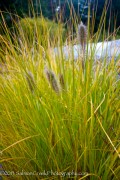
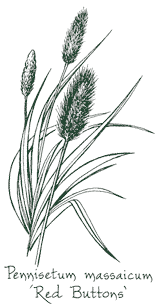
The species inhabits the wide open savannas of Africa, and this distinctive red flowered cultivar will flourish in your garden, given a well-drained sunny locale. Waving bushy, warm-colored inflorescences that eventually lighten to a creamy tan, the delicate slender stems rise high above graceful mounds of broad maroon-tinted green blades. Long-blooming ‘Red Buttons’ can be featured as a stellar addition to floral arrangements, as a container subject or a mixed border specimen, abiding hot dry conditions, but not terribly cold winters.
Blooms July – September
Size: 2' 0" – 3' 0" high x 2' 0" – 3' 0" wide.
Hardy to zone 7.
Each $13.00
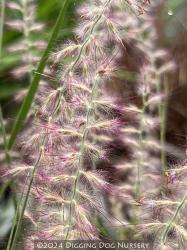
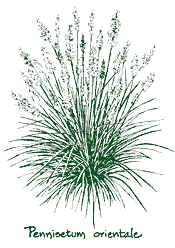
A dense, rounded clump of narrow arching leaves explodes into long blooming, fuzzy, copper-pink flower spikes, exquisite in large drifts or contrasted with broad-leafed perennials, like Helenium ‘Zimbelstern’. Backlight this grass and enjoy a fountain of color and youth.
Blooms June–October.
Size: 12" – 2' 0" high x 2' 0" wide.
Hardy to zone 6.
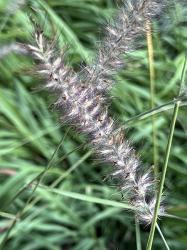
Vastly superior to the species, ‘Karley Rose’ heralds darker, larger and longer lasting blooms, deeper green leaves and improved winter hardiness. A bevy of full pouffy inflorescences, painted in hazy rose-purple shades, flows from a uniform, dense, arching base that exudes elegance, bestows bright yellow autumn color and needs little attention. Well-loved by garden designers, flower arrangers and birds, this outstanding Pennisetum orientale sport was discovered by David Skwat at Sunny Border Nursery and named for his daughter. (pp#12,909)
Blooms June–October
Size: 3' 0" high x 2-1/2' wide.
Zone 5/6.
Pennisetum orientale ‘Tall Tails’ (G-0093)
Each $13.00
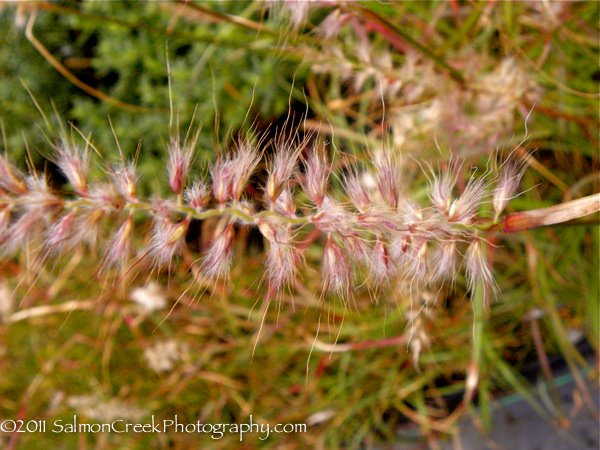
Vigorous and heat-loving, and much larger than the species, this bushy Pakistani cultivar has a 3 to 4 ft. vase-like clump of green foliage, with wonderfully whitish “tails” touched by a muted pink ascending a full foot higher. Giant Fountain Grass makes a compelling ingredient in the mixed border, especially with tall Achilleas and Angelica gigas nearby. .
Blooms June–October
Size: 5-1/2' high x 3' 0" wide.
Hardy to zone 6.
Pennisetum slopeduroides ‘JS Jommenik’ (G-0597)
Each $13.00
Springing forth as a gilded sport of Pennisetum ‘Gelbstiel’ in Jan Spruyt’s Belgian nursery, this splendid rounded Fountain grass boasts a Midas touch. Neat compact foliage transmutes golden springtime tones that mature to chartreuse, then transform to light green once summer’s heat takes hold. The no-fuss small-sized clump packs a wallop of bling for containers or space-thrifty niches, while fluffy tail-style khaki-colored plumes perched on 2 ft. tall stalks add blithe appeal. (pp#27,435)
Blooms August–October
Size: 2' 0" high x 2' 0" wide.
Hardy to zone 6.
Pennisetum spathiolatum (G-0511)
Each $13.00
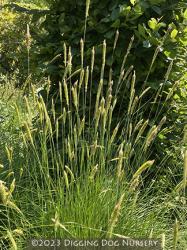
A denizen of South Africa, this drought tolerant evergreen grass has low-growing narrow dark green blades that provide a verdant contrast to its caramel-colored tapers. The dense, abundantly produced inflorescences hover on jointed nearly invisible stems, some 2 to 3 ft. tall, while fashioning a playful see-through veil. Especially mesmerizing when grouped in a dry creek bed, a meadow or a water-wise garden, the Slender Veldt Grass asks only for a well-drained abode.
Blooms June–October
Size: 3' 0" – 4-1/2' high x 2' 0" wide.
Zone 6/7.
Poa
Bluegrass
Each $12.00
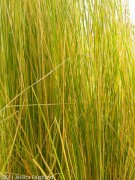
Silvery flower heads that sway just above lustrous fawn-green blades and an amazing drought tolerance hallmark this graceful New Zealand native. Found in open grasslands from coastal to subalpine regions, Silver Tussock produces a dense fine textured mound and upright arching stalks studded with slender, loosely arranged inflorescences. Easy-to-grow Poa cita looks best in drifts and knows how to persevere, doggedly enduring dry sunny niches, exposed windy sites, and an array of soil types.
Blooms July – September.
Size: 2-1/2' high x 2' 0" wide.
Zone 7/8.
Schizachyrium
Little Bluestem
Prevalent in the eastern half of this country, Schizachyriums are becoming a favorite of gardeners everywhere. These warm season clumping grasses have narrow soft-looking blades, though most of the plant’s height is due to its flower spikes: sheer fluffy plumes of steel-hued seed heads that look great backlit or as part of a cut arrangement. Deciduous and drought tolerant, they will grow in almost any type of soil except those overly soggy.
True to its name, ‘Blaze’ displays intense fall colors ranging from pinkish orange to russet-red to purple, often persisting through the winter. This Schizachyrium works well en masse interspersed with other grasses or as a colorful stand-alone in the rock garden.
Blooms July–October
Size: 12" – 2' 0" high x 2' 0" wide.
Hardy to zone 4.
Discovered by Donald Boehm in Rushville, Illinois, this distinctive, broad bowl-shaped grass sprouts narrow, tightset violet-tinged blue-green blades on reddish stalks plus fluffy mercury-hued plumes with delicate, nearly transparent seed heads. Exceptional copper, rosy tan, orange and mahogany shades imbue the foliage and flowering stalks once cool weather arrives, proclaiming the cultivar name and painting prismatic fine textured accents across the garden. Later, narrow sturdy stems blanch to a warm almond-hue and remain dutifully upright all winter, even after multiple snow storms.(pp#20,948)
Blooms July–October
Size: 2-1/2' high x 2-1/2' wide.
Hardy to zone 3.
Another fabulous Intrinsic grass introduction, this Schizachyrium ‘The Blues’ offspring orchestrates a winning shorter stance than its relation plus upstanding glaucous steel blue blades. Dainty racemes of bronzed purple flowers on branched stems give way to fleecy looking translucent silver seed heads that gleam when backlit by the late afternoon sun, while mauve and purple shades dress the slender linear leaves in autumn. Adaptable, versatile and plucky, ‘Jazz’ is a grace note for mixed borders, cottage gardens or stylized prairie settings.
Blooms July–October
Size: 2' 0" high x 18" wide.
Hardy to zone 3.
Schizachyrium scoparium ‘Minnbluea’ (G-0598)
Each $13.00
Discovered amongst a field of seedlings by Mary Meyer at the University of Minnesota, this outstanding new cultivar grows taller than the species and touts a valiant prismatic stance. Nonflopping, upright light blue foliage deepens to blue-gray, then later imparts vibrant violet and burgundy for summer, while heralding fall with pink, wine-red, purple and coppery-orange tones. Above the dashing, slim flattened leaves, a bird-friendly array of glossy purplish panicles and eye-catching, silver-haired tan seed heads add extra panache. (pp#17,310)
Blooms August–October
Size: 3' 0" – 4' 0" high x 2' 0" – 3' 0" wide.
Hardy to zone 3.
Schizachyrium scoparium ‘Prairie Blues’ (G-0524)
Each $13.00
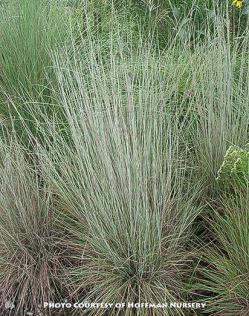
Cool-hued consistently steel blue blades sizzling with orange and red hues as summer wanes, is what sets this improved Jelitto Seeds cultivar apart. Easily tolerating heat and humidity, ‘Prairie Blue’s lavender-tinged ribbon-like foliage grows into a sturdy upright clump that looks outstanding planted in drifts just about anywhere.
Blooms July – October
Size: 3' 0" high x 15" – 2' 0" wide.
Hardy to zone 4.
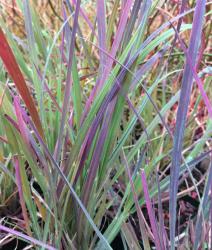
Introduced by Pennsylvania’s North Creek Nursery, this new cultivar’s tidy upright stature gives you good reason to applaud nearly year round. The sturdy bundle of tight-knit blue stems with purple-hued bases and spiky blue-green blades, thicker than most in the genus, promotes a dogged constitution, splendid foliar colors and an arresting winter persona. Gauzy pewter-hued inflorescences plus the autumn encore of scintillating orange, red, ocher and purplish mocha shades further enhance ‘Standing Ovation’s strong performance that will keep you entertained in spite of rain, high wind, snowfall and dry impoverished sites. (PPAF)
Blooms July–October
Size: 3' 0" – 4' 0" high x 12" – 18" wide.
Hardy to zone 3.
Schizachyrium scoparium ‘The Blues’ (G-0081)
Each $13.00
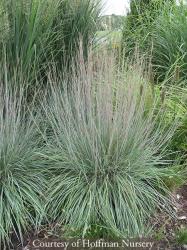
Acclaimed nursery owner Kurt Bluemel selected this superb cultivar from a group of S. ‘Aldous’ seedlings. The slender upright habit is defined by rosy-pink stems and fine-hewn steel-blue leaves that greet autumn with mulled purple, burgundy and russet tones. Fluffy silver seed heads plus lucent amber-hued winter foliage offer late season appeal. Enduring clay soil, humidity and heat, ‘The Blues’s tenacious demeanor brings colorful, nearly year-round vertical accents to smaller gardens, prairie-style plantings and water-wise landscapes.
Blooms July–October
Size: 2-1/2' – 3' 0" high x 18" – 2' 0" wide.
Hardy to zone 3.
Schoenoplectus
Zebra Rush
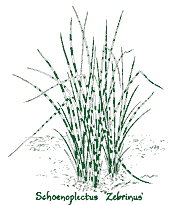
A lively pattern of ½ in. wide alternating alabaster and bright green bands decorate the upright hollow blades, which emerge in spring. The green gradually darkens, while the alabaster develops a luminescent quality that will surely brighten any shady spot and add striking detail to floral arrangements, fresh or dried. Brownish conelike terminal flower spikes are subtle and provide interest. This water-loving Japanese Sedge is happiest at pond’s edge or in a partially submerged container.
Blooms late June–August.
Size: 5' 0" – 6' 0" high x 0" & spreading wide.
Hardy to zone 7.
Sesleria
Moor Grass
This genus of reliable cool-season grasses pays homage to Leonardo Sesler, an 18th century Venetian botanist and physician who studied European flora. Sesleria’s long-lived carefree clump makes a superlative ground cover for intimate gardens or larger scale plantings.
Each $12.00
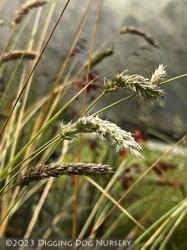
Our list of garden-worthy Sesleria is quickly growing and we’re pleased to add this well-groomed no-fuss species, hailing from southwestern Europe and northern Africa. Narrow green leaves propel numerous firm slender stems topped with a luminous flurry of silver-laced white blooms that make splendid cut flowers. Light green in dappled shade and more chartreuse when exposed to sunny drier conditions, the steadfast semievergreen mound can grace a stylized meadow, the rockery or the edge of a pathway.
Blooms July–October
Size: 16" – 20" high x 12" wide.
Hardy to zone 4.
Each $12.00
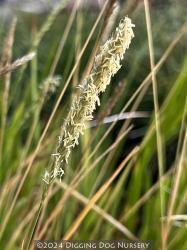
Indigenous to southern Europe and the Caucasus region, this accommodating grass emphasizes a low orderly mound of slender, rich yellowish green blades garnished with narrow spiky silver-white inflorescences in autumn, which later morph into attractive golden-tan seed heads. Easy-care Autumn Moor Grass is favored by many gardeners, especially acclaimed plantsman Piet Oudolf, who has utilized broad sweeps at both NYC’s Highline Garden and the Lurie Garden in Chicago. Ideal planted as an expansive ground cover for informal settings, Sesleria autumnalis’ tufted nearly evergreen clump looks spiffy most of the year, triumphing over erosion, light shade, black walnuts and infrequent dry spells, plus clay, sandy or alkaline soil.
Blooms September–October
Size: 15" – 20" high x 12" – 18" wide.
Hardy to zone 4.
Sesleria x ‘Brushstrokes’ (G-0613)
Each $12.00
A superb, recently introduced evergreen hybrid from grass aficionado John Greenlee’s previous southern California nursery, this versatile 12 to 16 in. high, dense clumping grass yields slim two-toned blue-green blades. The honey-hued volumes of plump, ample-sized inflorescences crest nearly 2 ft. tall, slender sturdy stems, while performing an extraordinary light-catching dance when the wind whooshes through. Tailor-made for meadow-style gardens, peppy ‘Brushstrokes’ enchants the butterflies, endures variable soil conditions and lends handsome well-behaved accents to mixed borders and mass plantings. (PPAF)
Blooms June–October
Size: 2-1/2' – 3' 0" high x 2' 0" wide.
Hardy to zone 4.
Each $12.00
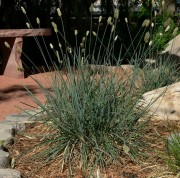
This European native’s sturdy tuffet fashions a long-lived and versatile, noninvasive ground cover. Easily cultivated, low-growing Blue Moor Grass puts forth a dense evergreen mound of soft, two-toned leaves, which are glaucous blue on top and dark green beneath. The twisted and curvy leaves present a cool blue-green base for small spiky panicles of purplish black flowers that mature to a silvered green. With enough fortitude to handle cold weather and alkaline soils, Sesleria caerulea is unrivaled as a filler between larger grasses or for edging a pathway, and equally impressive when massed.
Blooms March–June
Size: 8" – 12" high x 8" – 12" wide.
Hardy to zone 4.
Each $12.00
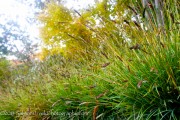
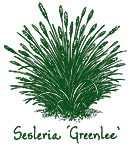
Exhibiting attributes from both parents, this trim-looking evergreen, discovered by grass aficionado John Greenlee, is thought to be a hybrid between Sesleria caerulea and Sesleria autumnalis. Blue-tinged green blades bear a likeness to Sesleria caerulea’s, but are longer, while the blooms resemble those of Sesleria autumnalis, except for being thicker, more elongated and for turning a purplish brown hue when mature. Topped by reflective green inflorescences with creamy-yellow pollen sacs, thin stems rise well above the amenable upright clump that withstands a multitude of exposures such as sun, shade, moisture, heat and drought. ‘Greenlee’s sprightly verdant form can be massed in a meadow or a more formal setting.
Blooms June–October
Size: 12" – 15" high x 15" – 18" wide.
Zone 6/7.
Always tidy, sadly underused and simple to maintain, the tufted silvery-blue mound of this dapper European denizen spawns a taller habit, broader blades and larger blooms than those of Sesleria caerulea. Copious early-flowering ebony-colored inflorescences with creamy-yellow pollen sacs are perched on slender upright stems, which eventually slacken and bend sideways above glaucous grayish green semievergreen leaves, donning crisp dark green undersides. Appreciative of adequate moisture plus a light trimming to refresh its pert visage, Sesleria heufleriana withstands dry conditions once established, makes an attractive cohort for spring bulbs and looks striking when planted en masse, either beside a path or in a border.
Blooms April–August
Size: 2' 0" high x 18" wide.
Hardy to zone 4.
Each $12.00
Populating central and southern Italy and often found in calcium-rich mountainous areas, Gray Moor grass is the tallest Sesleria we offer. Dense, tufted mounds of narrow, pointy gray-green blades imbued with cool blue shades cushion the cone-shaped dark chocolate-colored blooms that don bright greenish yellow anthers. Drought tolerant near cooler coastal areas, Sesleria nitida maintains a winsome year-round presence plus makes a sturdy no-fuss candidate for mass plantings in larger gardens or singularly where space is limited.
Blooms May–early July
Size: 18" – 2' 0" high x 15" wide.
Hardy to zone 4.
Each $12.00
Native to Austria, Hungary, Yugoslavia and the Czech Republic, this delightful semievergreen grass develops luminous woolly-looking white blooms and a resilient lime-loving bent. Stiff linear, smooth green blades with prominent veins compose an upright compact clump that supports the ample showing of plump oblong-shaped inflorescences atop short stout stalks. Unhampered by shade and occasional drought, Hungarian Bluegrass can be massed as a ground cover, planted amid the rockery or ensconced up front in a mixed border, where it prefers sunshine or dappled light plus dry to moderately-moist soil.
Blooms March–May
Size: 15.8" high x 15" – 18" wide.
Hardy to zone 5.
Spodiopogon sibiricus (G-0456)
Each $12.00
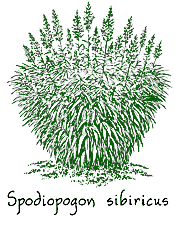
The lush, bamboo-like appearance of Siberian Graybeard brings echoes of Manchurian forests into your corner of the world. Initially bright green, the 6 to 8 in. long flat leaves gently taper to a point, and splay in a dramatic horizontal effect later in the season as rich plum-red highlights appear. Rising over a foot above the neatly rounded, bushy profile, unusual 8 to 12 in. purple-blushed, open and erect panicles are napped with fine hairs—excellent light catchers in the afternoon sun. Planted as a bold architectural specimen or grouped as a stylish screen, its upright habit and sumptuous fall coloration look pleasing with Aster ‘Ochtendgloren’ and Crocosmia ‘Harlequin’. Tending to mope in dry, hot weather, it will flourish in light shade and well-drained soil.
Blooms July–late October
Size: 4' 0" high x 3' 0" – 3-1/2' wide.
Hardy to zone 5.
Sporobolus
Prairie Dropseed
This somewhat slow growing, yet long-lived North American prairie grass is the queen of refinement, affording grace, fortitude and versatility. A popular attraction for birds and once ground into flour by Native Americans, open lace-like panicles give way to countless seed heads that waft a unique cilantro and spiced popcorn aroma. Prairie Dropseed requires minimal care and once mature, braves drought plus an variety of soil types, though it’s happiest in moist fertile sites.
Spotted in a Wisconsin field by prairie enthusiast Neil Diboll, a trim, tightset green mound launches as many as 100 strong, lanky cardinal-colored culms, which resist the urge to droop. Uniquely displayed at a fairly uniform height, the gauzy reddish flower panicles and innumerable seed heads coupled with a more compact habit set ‘Morning Mist’ apart from other Sporobolus species. This new upright, yet somewhat arching cultivar boasts sturdy good looks, transmutes glowing golden-orange tones in fall and lends a fine-hewn rubescent flair to informal garden settings. (pp#14,344)
Blooms August–October
Size: 2' 0" – 3' 0" high x 2' 0" – 3' 0" wide.
Hardy to zone 3.
Sporobolus heterolepis ‘Tara’ (G-0567)
Each $13.00
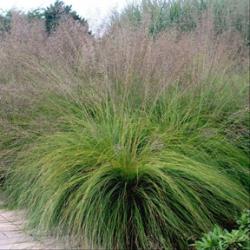
More compact, slightly stiffer and definitely smaller than the species, this upright fine textured dwarf cultivar was selected by astute nurseryman Roy Diblik. ‘Tara’ is a tough warm season grass, which forges a tasteful vase-shaped green foundation beneath the exquisite wispy gathering of numerous minute pinkish purple inflorescences on slender stems. Mature, round seed heads drop to the ground, hence the common name, while narrow foliage blazes red and orange for autumn. Enticing birds and gardeners, especially those who have limited space, heat-tolerant Dwarf Prairie Dropseed can assort with Echinacea, Monarda or Nepeta in borders and meadows or on slopes.
Blooms August–October
Size: 2' 0" high x 2' 0" wide.
Hardy to zone 4.
Considered the most urbane of the American prairie grasses, ‘Wisconsin Strain’ parades early reliable blooms plus a debonair fountain-style presence. Sublime when illuminated by the afternoon sun, a grand misty floral froth hovers well above an upright arching 1 to 2 ft. tall, finely cut emerald-green hummock. Enticements prevail as tiny ethereal-like pink and brown inflorescences mature into copious tawny-colored seed heads, while soft looking leaves turn opulent burgundy, gold or burnt tangerine hues in autumn, later showcasing light copper tones for winter.
Blooms July–September
Size: 3' 0" high x 3' 0" wide.
Zone 3/4.
Originally bred by New Mexico’s Los Lunas Plant Materials Center to be a utilitarian non-woody windbreak, this enormous grass pleasantly surprised everyone with its majestic bearing plus spectacular blonde and bronze-colored fluffy flower spikes.
Strap-like medium green foliage boldly forges a sturdy upstanding foundation, touted as the largest of all native American grasses. Possessing a versatile, non-invasive practicality unlike the Victorian era’s Pampas Grass, ‘Windbreaker’ makes a top-notch choice for a living fence, hedgerow or an awe-inspiring ornamental specimen in a mixed border.
Size: 7' 0" – 10' 0" high x 6' 0" wide.
Hardy to zone 5.
Stipa

The species of this widely distributed genus of cool season grasses are evergreen in milder climates. All are clump forming and most relish well-drained soil and low humidity. Perfect for cut arrangements, the flowers shimmer in morning and end-of-the-day light, and in the breezes of any hour.
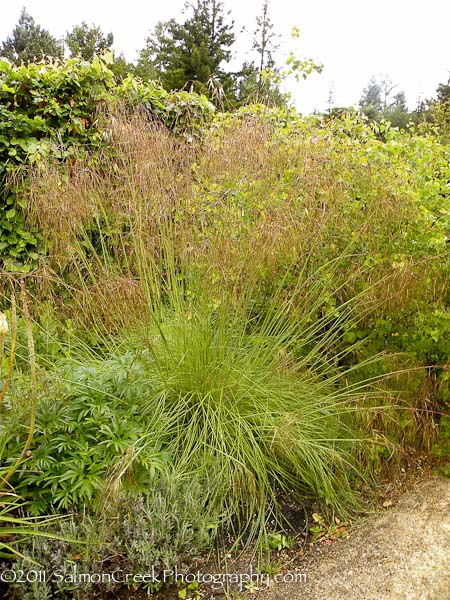
Like a fountain, the green, bronze and golden narrow blades are upright and arching. Slightly dry soils will intensify the copper tones of this graceful, clumping evergreen Stipa. While grown mostly for its delightful form and color, the subtle inflorescences appear as a fine mist, tinged with small purple and golden seed capsules known as awns.
Blooms June–September
Size: 2' 0" high x 2' 0" – 3' 0" wide.
Hardy to zone 8.
Each $13.00
Deemed one of the most graceful and floriferous habits amongst the mid-statured grasses, adaptable Silver Spike Grass hails from high-elevation open spaces in central and southern Europe’s mountainous regions. Finely-hewn medium green foliage distinguishes a rounded snug tuff beneath slender curved stems and large, delicate silver-green plumes, later donning warm tawny tones. A wildly elegant AGM recipient, Silver Spike Grass evokes flowing water with its long-lasting, cut-flower-perfect silken panicles plus ultra-posh leaves that remain semievergreen in mild locales. Stipa calamagrostis can be added to sunny water-wise gardens, well-drained mixed borders and meadows, either en masse or as a specimen. It relishes low humidity as well as cool summer nights, detests too much fertility and endures dry, rocky alkaline sites.
Blooms July–September
Size: 3' 0" high x 3' 0" wide.
Hardy to zone 7.
Each $13.00
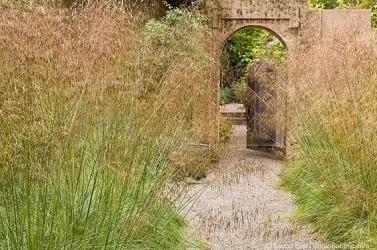
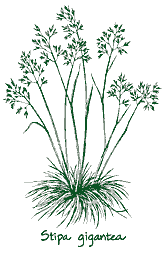
Native to Africa and southwestern Europe, this magnificent grass hoists 7 ft. tall, bamboo-like jointed stalks crowned with airy 10 in. panicles of oat-like flowers that emerge as purple-on-green, then ripen to pale metallic gold. The unforgettable floral display continues all fall above a dense fluid-looking 2 ft. hummock defined by tidy narrow green blades. Position Giant Feather Grass so it can be backlit, and a stunning effect is yours for the viewing.
Blooms June–November
Size: 6' 0" – 7' 0" high x 4' 0" wide.
Hardy to zone 7.
Each $12.25
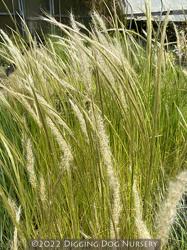
From Peru’s grasslands and rocky plains, this evergreen bunching grass rallies both durability and finesse. Ultrathin bright green blades grow in an upright fashion and sport rolled edges coupled with toasty amber fall hues. Swaying just above the fine-cut tuft, a glimmering feather-like array of long, silken silvery-green plumes appears in early summer and later broadcasts golden tones once mature. Undaunted by deer, heat, coastal sites and dry conditions, Peruvian Feather Grass is tailor-made for slopes, erosion control, massed plantings and mixed borders, as well as containers. Sunshine, superb drainage, protection from winter cold plus fertile soil ensure its good fortune.
Blooms July–September
Size: 2' 0" – 3' 0" high x 12" – 2' 0" wide.
Zone 7/8.
Each $13.00
Hailing from Down Under, Australia’s ‘Pillar of Smoke’ explodes with 6 to 8 in. whorl-branched panicles of silky copper-colored flowers that age to a smoky silver. The amazing floral plumes are held on sturdy, jointed stems amidst towering clumps of bright green foliage.
Undaunted by wind, poor soils and some drought, this strong-growing, cool season evergreen is perfect for southern and western gardens, as well as coastal sites.
Blooms February–September
Size: 6' 0" – 7' 0" high x 3' 0" wide.
Hardy to zone 9.
Thamnochortus insignis (G-0084)
OUT OF PRODUCTION AT THIS TIME
Email me when this plant is available
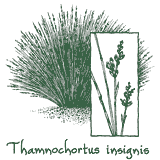
Exhibiting a kinetic sculptural quality in the wind and a graceful architectural flair all year, slender, unbranched reedlike stems tipped with small golden inflorescences spring from a dense basal tussock. Its tidy and tenacious upright habit prefers good air circulation and acidic soil, and abides drought, frost and seaside conditions once established.
Hailing from the South African coast between Cape Agulhas and Albertinia, Thamnochortus insignis is commonly utilized to thatch traditional Cape Dutch homes, and can be featured in your garden as a dramatic long-lived specimen.
Blooms July – August.
Size: 5' 0" – 6' 0" high x 5' 0" – 7' 0" wide.
Hardy to zone 8.
Thamnochortus spicigerus (G-0520)
OUT OF PRODUCTION AT THIS TIME
Email me when this plant is available
Dense handsome tussocks of artful arching blue-green culms are topped with bronzy wheat-like flowers on tall spikes. Seemingly impervious to heat, wind and coastal conditions and tolerant to both acidic and alkaline soils, this rhizomous grass will delight with prominence and longevity.
Blooms October–December.
Size: 4' 0" – 5' 0" high x 3' 0" wide.
Hardy to zone 8.
OUT OF PRODUCTION AT THIS TIME
Email me when this plant is available
This toasty-hued New Zealand native is highly treasured for narrow, rich mahogany blades arching up and out from its base to forge a burnished tuft warmed by reddened accents. Tiny, Bulrush-like, hooked flowers are elevated above the tidy, low growing evergreen clump that flourishes in cool moist places but sulks in excessive heat.
Massed at water’s edge or nestled in a cobalt blue container, Uncinia rubra strikes a stunning pose with Bergenia ‘Bressingham Ruby’s textural leaves or the rounded foliage of Lysimachia ‘Aurea’ as a golden counterpoint.
Blooms June–August.
Size: 12" – 15" high x 15" wide.
Zone 7/8.
Uncinia rubra ‘Belinda's Find’ (G-0537)
OUT OF PRODUCTION AT THIS TIME
Email me when this plant is available
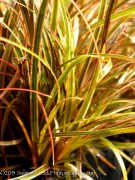
A real find for any gardener, this dazzling sport brandishes narrow lustrous bronze leaves with bright cherry red margins. The full-toned blades comprise a small loosely set clump that can accompany broader like-hued foliage, such as Heuchera 'Blackout', for an intriguing color echo or serve as an effective counterpoint against silver and blue-hued leaves. Celebrate 'Belinda's Find's vivacious accents in a courtyard, shady bed or favored container. (uspp#21,972)
Blooms June–August
Size: 12" high x 15" wide.
Hardy to zone 8.












